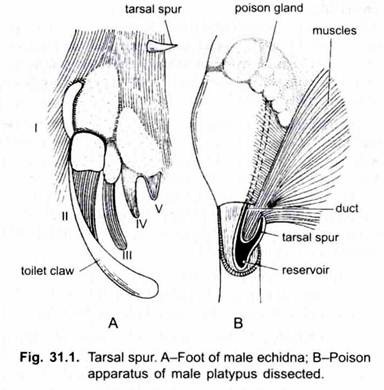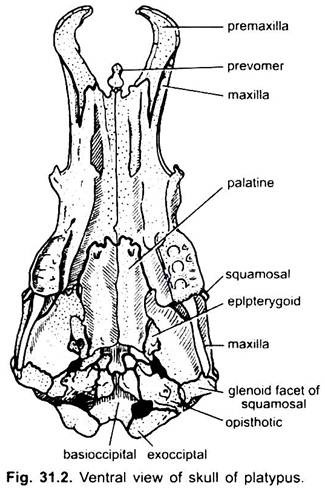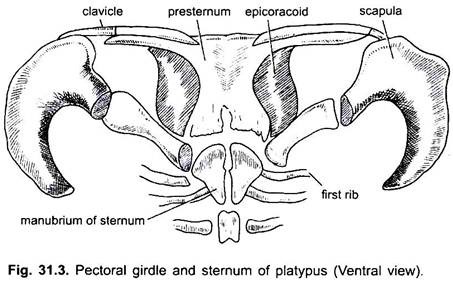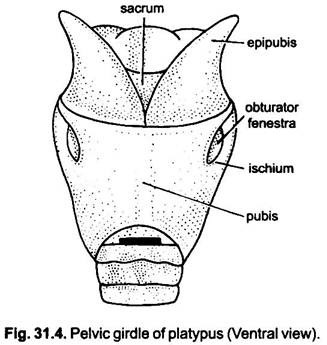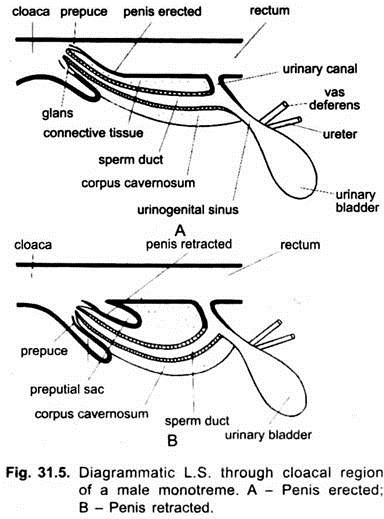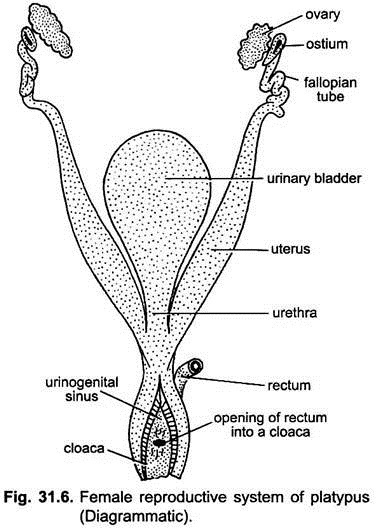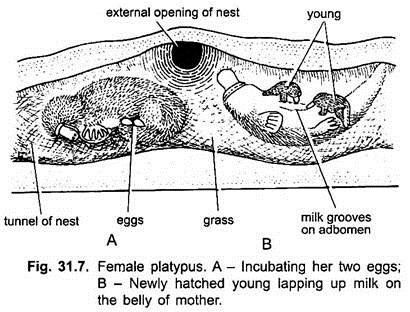In this article we will discuss about the distinctive characters of platypus with the help of suitable diagrams.
Habits and Habitat:
The platypus is highly modified for aquatic life and spiny ant-eaters are terrestrial. Both are burrowing in habit, both burrow and make nests for rearing their youngs. Both are insectivorous, nocturnal, warm-blooded, quadrupedal and oviparous.
External Features:
Body of platypus is flattened and covered with a dense, soft under-fur protected by harsher outer fur. Body of spiny ant-eaters is covered above with strong pointed spines, between which are coarse hairs, while the lower surface of the body has only hairs.
In platypus jaws are produced into a depressed beak covered with soft, but tough skin. In spiny ant-eaters jaws are produced into a long sensitive pointed rostrum. External ears or pinnae are absent. Tail flat and elongated in platypus and vestigial in spiny ant-eaters.
Mammary glands devoid of nipples. Mammary pouch on the abdomen of female is present in which milk is secreted through large number of (120) specialised sweat glands, but the ducts of these are not united to open on central nipples.
In platypus, forelegs are short and powerful. The five digits are webbed and end in strong claws. Hindlimbs are less specialised. In the male a hollow tarsal spur is connected with a small crural gland whose secretion is poisonous. This gland is well developed in platypus and less developed in spiny ant-eaters.
Exoskeleton:
The platypus has five short dark brown epidermal hairs, whereas spiny ant-eater’s back is covered by a mixture of spines and hairs, and the belly has hairs only. Skin is glandular.
Body Cavity:
It is divided by a typical mammalian diaphragm into an anterior thoracic and a posterior abdominal cavities.
Endoskeleton:
(i) Skull:
Dicondylic. The bones of skull early become fused together showing no trace of their boundaries. Brain case is larger and much more rounded in spiny ant-eaters than in platypus. Unlike higher mammals, pterygoid bones are separate. Parasphenoid is also present like lower vertebrates.
Temporal canal perforates the posterior part of zygomatic arch, absent in higher mammals. Zygomatic arch is stouter in platypus than that of spiny ant-eaters. Postorbital process formed by jugal is present in platypus and absent in spiny ant-eaters. The nasal and premaxillaiy are drawn out into rostrum bearing external nares in both. Tympanic is not united with the periotic. Small prefrontal and postfrontal bones are present. Lacrimals and alisphenoids are absent.
Mandible stouter in platypus and meet anteriorly a short distance and then again diverge and narrow styliform in spiny ant-eaters and loosely united at the symphysis. Coronoid process is rudimentary. Ossicles in spiny ant-eaters are fused, and separate in platypus. Quadrate, articular and tympanic have entered the ear.
ADVERTISEMENTS:
(ii) Vertebral Column:
The epiphyses of the vertebrae are not well developed in platypus and absent in spiny ant-eaters. Cervical vertebrae are normal and zygapophyses are absent. Atlas- axis complex is present. Thoraco-lumbar vertebrae are nineteen with short transverse processes. Sacrum has three or four united vertebrae in spiny ant-enters, and two in platypus, caudal vertebrae in spiny ant-eaters depressed, with no inferior spines but with about five sub-vertebral bones in the form of flat nodules.
In platypus tail caudal vertebrae are twenty or twenty one, each with an inferior spinous process. Ribs articulate with the bodies of the vertebrae and not with transverse processes (i.e., single-headed – only capitulum).
(iii) Sternum:
It consists of a presternum and three keeled stembrae. Xiphisternum only in spiny ant-eaters and not in platypus. Interclavicle is T-shaped like reptiles. Sternal ribs are ossified and connected with vertebral ribs by imperfectly ossified intermediate ribs.
(iv) Girdles:
In the pectoral girdle there are separate clavicles and a median T-shaped interclavicle. Coracoid region has two separate bones, coracoid and precoracoid. In front of coracoid is the epicoracoid. The scapula is unlike that of other mammals and with well-developed acromian process and without spine.
In pelvic girdle pubes and ischia form a long symphysis. With the anterior border of pubes are articulated a pair of large epipubic or marsupial bones, presumably for the support of the marsupial pouch.
(v) Limb Bones:
ADVERTISEMENTS:
Humerus with greatly expanded extremities and prominent turbidities and condyles. Fibula is expanded at its upper end like the ulna of other mammals. In the carpus the scaphoid and lunar are united and no separate centrale. There are a radial and two large palmar sesamoid, which are sometimes united.
Femur with expanded extremities and with external and internal trochanters. There is a large ossified patella. The fibula has at its proximal end a compressed process like olecranon process of ulna. Tarsus has usual bones. In platypus the astragalus and calcaneum are firmly united and in male there is an accessory ossification on the inner side for the tarsal spur. Metatarsals are as usual.
Digestive System:
In spiny ant-eaters, teeth are absent in all stages of development. In young platypus flattened, rigid teeth are present and these are replaced by horny structures, formed by an in growth of epidermis beneath them and used for breaking the shells of molluscs.
Spiny ant-eaters have a tiny round mouth at the end of long beak. In spiny ant-eaters posterior part of tongue is beset with horny serrations which grind the food against corresponding ridges on the palate. Submaxillary, parotid and sublingual glands are present whose secretions help to neutralise formic acid discharged by their preys, ants.
The stomach of monotremes is almost globular, intestine is differentiated into small and large, and caecum is also present. Rectum opens into the cloaca posterior to the ureters and vasa deferentia. Liver is large and there is a gall bladder with bile duct which traverses the cloaca prepuce penis erected rectum pancreas and joins the pancreatic duct.
Respiratory System:
Respiration is pulmonary, by lungs. Larynx is also present.
Circulatory System:
Heart is 4-chambered. Right auriculo-ventricular valve is incomplete and partly muscular. There are no chordae tendinae. Left auriculo-ventricular aperture is guarded by tricuspid valve, not by bicuspid as in other mammals. Single left aortic arch resembles those of other mammals. There are no renal portal veins. In spiny ant-eaters an anterior abdominal vein, arising on the bladder and distributed to the liver. Erythrocytes are small, circular and non-nucleated.
In monotremes heat regulation is imperfect though far advanced over that of living reptiles. In the absence of sweat-glands, heat-reduction by vasodilation occurs. The temperature of spiny ant-eaters rises with that of the environment above 30°C and the animal dies of heat stroke at about 37°C, if unable to cool itself by burrowing. The platypus has few sweat-glands but it lives mostly in water or in a cool burrow.
Excretory System:
Kidneys are metanephric. Ureters do not empty directly into the bladder but open into the urethra through a common aperture over a papilla. The urine flows through a short urinary canal into the large urinogenital sinus. Therefore, it does not traverse the penis which carries only sperms. The glans penis is divided into four lobes and lies on the floor of the cloaca.
Nervous System:
Brain is essentially on the mammalian plan. Cerebral hemisphere is large and there is no corpus callosum which is found in eutherians. It connects the two lobes of cerebral hemispheres internally. The surface is smooth in platypus but in spiny ant-eaters neopallium is very large and convoluted, different from that of eutherians. Optic lobes are four (corpora quadrigemina).
Receptors:
The olfactory system of platypus is reduced. The eyes and ears are closed under water. In spiny ant-eater vision is good. In the internal ears of monotremes cochlea is partly coiled and contains an organ of Corti. Like reptiles it also carries lagena cochlea at its tip.
Reproductive System:
The rectum and urinogenital system open into a common cloaca. In male, testes are abdominal. The penis is attached to the ventral wall of cloaca and retractile into a sheath. It is used only for the passage of sperms. A pair of Cowper’s glands open into the canal of penis. The penis is composed of a corpus spongiosum, a corpus fibrosum and cavernous tissue is present round the urethra and in the glans penis.
The prostate and vesicula seminales are absent. In female, a pair of ovaries is present in the abdomen. The right ovary is smaller (not functional in platypus and rarely functional in spiny ant-eaters).
Vagina absent. The lower ends of oviducts are dilated into a kind of uterus and open into the urinogenital sinus in front of ureter. There are two glands opening into the sheath of the clitoris which are compared to the Cowper’s glands of the male (Owen).
Development:
Female is oviparous. Ova are large containing much yolk and surrounded by albuminous coat and a shell. Cleavage is meroblastic. No gestation. Echidna lays one egg at a time and placed in the mother’s pouch in which she incubates the egg for 10 days, whereas platypus lays two eggs at a time and placed in the nest in the burrow.
Monotremes possess a caruncle on the head as well as the egg-tooth for breaking out the shell. After incubation and hatching, the young enters the pouch of mother and is fed by milk.
